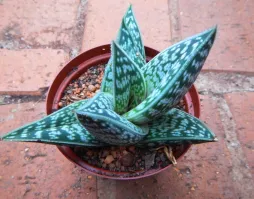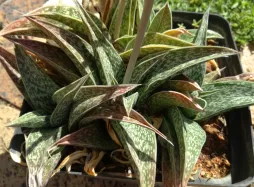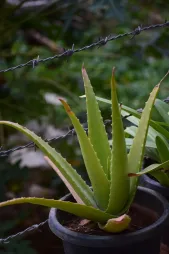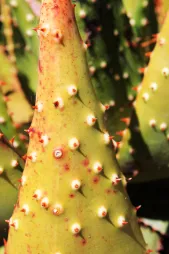Gonialoe variegata, a false variegated aloe
Discovered in 1685 in Namibia and South Africa, Aloe variegata has long belonged to the Aloe genus. But in 2014, the species was renamed Gonialoe variegata and became part of a new genus in the large Asphodelaceae family. It now forms the genus Gonialoe alongside Gonialoe sladeniana, Gonialoe dinteri and Gonialoe borealis.
How to recognize Aloe variegata (Gonialoe variegata)?
Gonialoe variegata is a succulent plant that grows to no more than 30 centimetres in height. It produces numerous shoots and, after a few years, forms dense bushes.
The plant is acaule. It forms a rosetteof around twenty leaves. They are arranged in three rows, each comprising between six and eight leaf blades.
The thick, rigid leaves are V-shaped, with a central gutter, and measure between 15 and 20 centimetres long. Dark green, they are edged with white. White, light-green or pale-yellow dots run through them, forming horizontal lines. The plant has no spines, but the margins of the leaf blades are finely serrated.
In its native habitat, Gonialoe variegata flowers in winter. A floral spike 20 to 30 centimetres high appears at the heart of the rosette. It is crowned by a cluster of pink or salmon flowers.
The fruit is a capsule. When ripe, it splits into three to release its winged seeds.
Aloe variegata is not harmful to humans. Some even claim it has medicinal properties. However, it is toxic to animals such as cats. Ingested, the plant causes digestive problems.
Our maintenance tips
Gonialoe variegata like light. But too much light can turn their leaves red. If you want your plant to keep its foliage green, avoid placing it in full sun.
Watering
Water only when the soil has completely dried out. Use room-temperature water with low calcium content, such as rainwater.
Water generously to allow the leaves to soak up the water. Make sure any excess water has drained away before replacing your Gonialoe variegata. If necessary, remove any water that has accumulated in the saucer or planter.
Spray
Gonialoe variegata grow in arid regions and do not like humidity. No need to spray them.
Repotting
In spring, transfer your Gonialoe variegata to a larger pot, so that it can continue to grow.
In a pierced pot, pour a layer of well-draining substrate. You can use commercially available potting soil for cacti and succulents, or make your own growing medium by mixing ordinary potting soil and sand.
Plant your Gonialoe variegata in the center and add soil. Be careful not to bury the leaves, and leave a watering trough.
Water generously to encourage rooting and expel air bubbles.
Fertilization
You can stimulate the development of your plant during its growth phase, in spring and summer, with fertilizer.
You can feed your Gonialoe variegata with a fertilizer for cacti and succulents.
Prune
Cut back the flowering stem after flowering.
Plantation
Once the last spring frosts have passed, you can plant.
Gonialoe variegata like sun and hate having their roots in water. For your plant to flourish, choose a bright location with well-drained soil.
Dig a hole the size of the root ball. Plant your Gonialoe variegata without burying the crown. Fill in and press down.
If you want to achieve a ground-cover effect, space the plants about 50 centimetres apart.
Seedling
Your seedlings need warmth. Summer is the best time to get started.
Prepare a mixture containing :
- One third potting soil ;
- One third sand ;
- One third drainage material (gravel, perlite or pozzolan).
Fill small pierced pots with your substrate. Plant your seed.
Keep your seedlings in a bright room with a temperature of at least 20 degrees.
Mist the soil to keep it moist, but not soggy.
Cutting
Separate a seedling, with its root system, from the mother plant. If their roots are intertwined, sever them with a clean knife.
In a pierced terracotta pot, pour a bed of clay balls or gravel to optimize drainage.
Prepare a mixture of one-third potting soil, one-third garden soil and one-third sand. Pour it into your pot, on top of the drainage layer. Plant your cutting and tamp it down.
Place the pot in a room where the temperature is always above 18 degrees. The location should be bright and out of direct sunlight. You can, for example, place your cutting behind a curtained window.
To avoid drowning the roots, always check the condition of the substrate before watering: the surface must be dry.
Disease / Threat
Information
| Family | Asphodelaceae - Asphodelaceae |
| Type | Gonialoe - Gonialoe |
| Species | Gonialoe variegata - Gonialoe variegata |
| Lifecycle | Perennial |
| Foliage | Evergreen |
| Exposure | |
| Substrats | |
| Planting methods |
Open ground In pots In tubs Planter |
| Category | |
| Tags |
Beginner Flowery Toxic |
| Origin |
South Africa |
| Hardiness (USDA) | 9b |
| Leaf color |
|
| Flower colors |
|
| Fruit color |
|
Discover plants from the same family
























